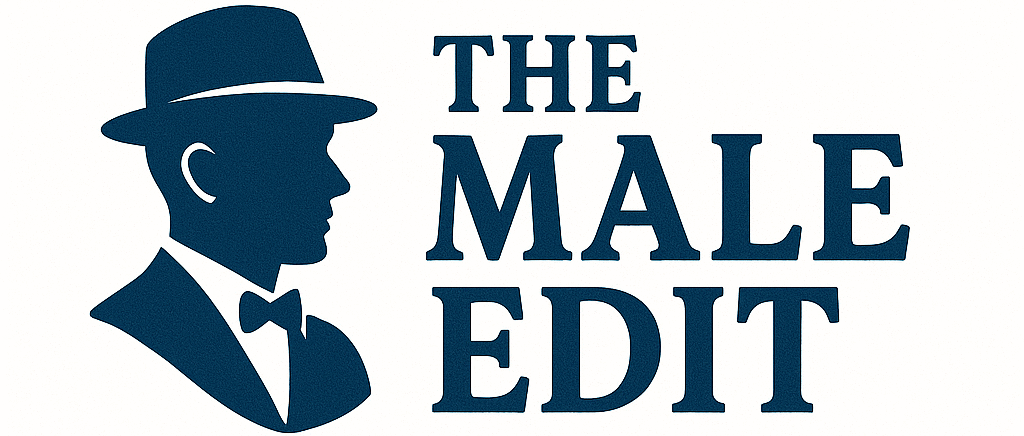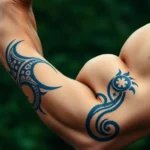We’ve all been there – scrolling through countless profile pictures trying to find that perfect balance between style and sophistication. Black and white DPs have become the ultimate game-changer for men who want to make a lasting impression on social media platforms.
There’s something undeniably powerful about monochrome photography that captures attention instantly. Whether you’re updating your LinkedIn profile or refreshing your Instagram feed black and white display pictures offer a timeless elegance that colored photos simply can’t match. They convey confidence maturity and artistic flair all in one frame.
The best part? You don’t need professional photography skills to create stunning black and white DPs. With the right techniques and a few simple adjustments you can transform any ordinary photo into a striking monochrome masterpiece that reflects your personality and style. Let’s explore how to master this classic aesthetic and elevate your online presence.
Classic Black and White Portrait Styles for Men
These timeless portrait approaches form the foundation of compelling black and white photography for men. Each style offers distinct advantages for creating memorable display pictures that stand out across social media platforms.
Traditional Headshot Approach
Traditional headshots focus on capturing clean, straightforward portraits that emphasize facial features and expression. We recommend positioning yourself directly facing the camera with your shoulders slightly angled to create depth. The lighting should be even and soft, typically coming from a large window or diffused light source positioned at a 45-degree angle to your face.
Composition matters significantly in traditional headshot photography. Frame the shot from mid-chest up, ensuring your eyes fall along the upper third of the image. Keep backgrounds simple and uncluttered to maintain focus on your face. Neutral expressions or subtle smiles work best for versatile display pictures that suit multiple platforms.
Camera settings for traditional headshots require careful attention to detail. Set your aperture between f/2.8 and f/5.6 to keep your face sharp while gently blurring the background. Focus precisely on your eyes, as they serve as the primary connection point with viewers. Shoot in RAW format to retain maximum detail for black and white conversion.
Professional Business Portrait
Professional business portraits demand a more formal approach that conveys competence and reliability. We suggest wearing well-fitted business attire like suits, dress shirts, or blazers that photograph well in monochrome. Solid colors and subtle patterns translate better than busy designs when converted to black and white.
Posture and positioning significantly impact the professional quality of business portraits. Stand or sit with your shoulders back and spine straight to project confidence. Turn your body slightly away from the camera while keeping your face toward the lens. This three-quarter angle creates a ever-changing yet professional appearance that works exceptionally well for LinkedIn profiles.
Lighting techniques for business portraits should create subtle shadows that add dimension without being dramatic. Position your main light source slightly above eye level and to one side. Add a fill light or reflector on the opposite side to soften harsh shadows. The goal is even, flattering illumination that highlights your features while maintaining professional polish.
Artistic Shadow Play Techniques
Artistic shadow play transforms ordinary portraits into striking visual statements through creative lighting manipulation. We achieve dramatic effects by using single light sources like desk lamps, window blinds, or architectural elements to cast interesting shadows across the face. These techniques work particularly well for Instagram and creative portfolio displays.
Directional lighting creates the most compelling shadow patterns in artistic portraits. Position yourself near venetian blinds, lattice work, or other objects that create repeating shadow patterns. Window light filtered through these elements produces natural, organic shadows that add visual interest. Experiment with different angles to find the most flattering shadow placement.
Post-processing enhances shadow play effects significantly in black and white portraits. Increase contrast to make shadows deeper and highlights brighter. Use local adjustments to darken exact shadow areas while keeping facial features visible. The key is balancing dramatic lighting effects with maintaining recognizable facial details for display picture purposes.
Minimalist Black and White DP Ideas for the Modern Man
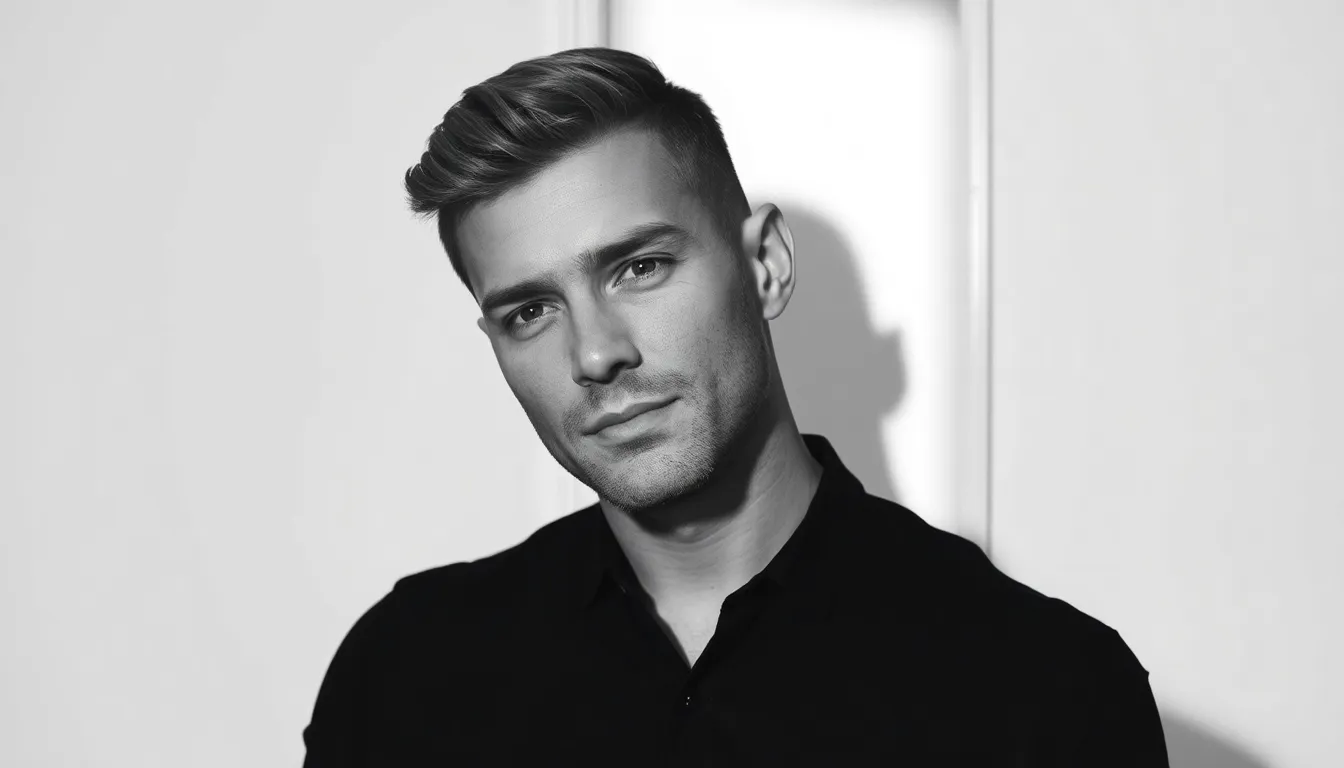
Modern minimalism transforms ordinary profile pictures into striking visual statements that capture attention through simplicity rather than complexity. We’ll explore three essential techniques that help create sophisticated monochrome DPs with maximum impact.
Clean Background Compositions
Clean backgrounds eliminate distractions and direct all attention to your facial features and expressions. We recommend using plain walls, solid surfaces, or softly textured backdrops that won’t compete with your presence in the frame.
Solid colors work exceptionally well for minimalist black and white photography. White walls, gray concrete surfaces, or black studio backdrops create the perfect foundation for your DP. These neutral tones translate beautifully into monochrome images.
Subtle gradients add depth without overwhelming the composition. We often see photographers use seamless paper backgrounds or natural wall textures that create gentle tonal variations from light to dark.
Focus remains entirely on you when background elements stay minimal. Your personality and expressions become the star of the image rather than competing with busy patterns or cluttered environments behind you.
Simple Lighting Setups
Soft lighting creates smooth transitions between highlights and shadows on your face. We achieve this effect using natural window light or a single softbox positioned at a 45 degree angle from your face.
High contrast lighting adds drama and emphasizes the structure of your facial features. This technique works particularly well for creating bold, masculine DPs that command attention on professional platforms.
Natural window light provides the most accessible option for creating beautiful black and white portraits. Position yourself near a large window during daytime hours for even, flattering illumination.
Single light sources produce the most effective minimalist setups. We avoid complex multi light arrangements that can create confusing shadow patterns and instead focus on one well positioned light source.
Light and shadow interplay becomes crucial in monochrome photography since we rely entirely on tonal variations to create depth and emotion in the image.
Geometric Framing Techniques
Geometric elements add structure and visual interest to your composition without cluttering the minimalist aesthetic. We incorporate lines, angles, and shapes that complement rather than distract from your presence.
Doorways and windows create natural frames that draw attention directly to your face. These architectural elements provide clean, straight lines that enhance the modern minimalist approach.
Off center positioning follows the rule of thirds to create balanced and visually compelling compositions. We place your eyes along the upper third line rather than centering your face in the frame.
Angular compositions guide the viewer’s eye through strategic placement of geometric shapes. Staircases, building corners, or even simple rectangular frames can add sophisticated structure to your DP.
Architectural framing enhances the overall artistic impact while maintaining the clean, uncluttered look that defines minimalist photography. These elements work as leading lines that naturally draw attention to your facial features.
Vintage-Inspired Black and White Profile Pictures
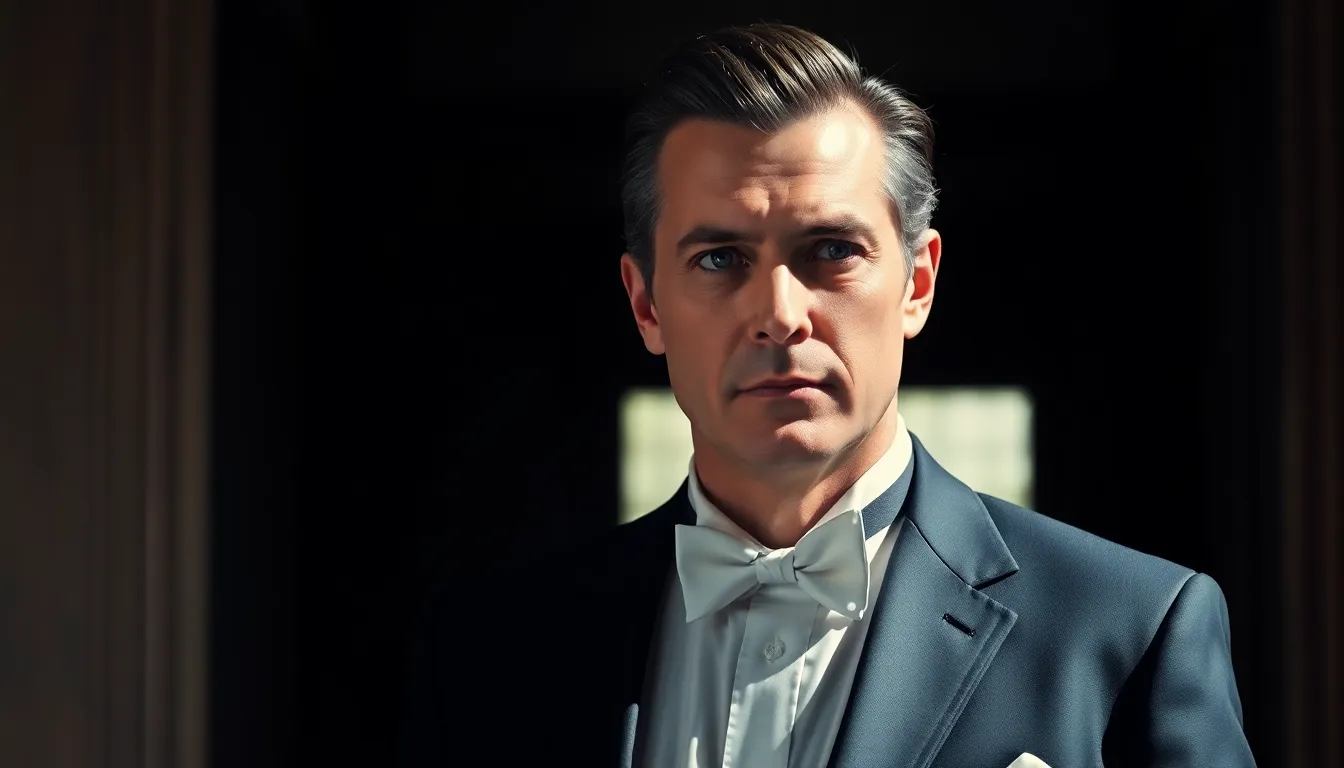
We’ve explored modern minimalist approaches, but now let’s jump into vintage aesthetics that capture the timeless elegance of early to mid-20th century photography. These nostalgic styles create sophisticated profile pictures that stand out with their classic charm and artistic depth.
Film Noir Aesthetic
Dramatic shadow work transforms your profile picture into a moody masterpiece reminiscent of 1940s cinema. Position yourself near a single light source to create sharp contrasts between light and dark areas of your face. We recommend using chiaroscuro lighting techniques that emphasize facial contours through strategic shadow placement.
Mystery and depth emerge when you incorporate film noir’s signature elements into your composition. Tilt your head slightly downward while maintaining eye contact with the camera to achieve that classic brooding look. Research shows that men’s profile pictures benefit from serious expressions that convey complexity and masculine mystique.
High contrast editing amplifies the dramatic effect of your vintage inspired portrait. Increase the contrast in post processing to create those bold blacks and crisp whites that define the film noir style. We suggest avoiding midtones to maintain the stark visual impact that makes these images so compelling.
Retro Hollywood Glamour
Golden Age sophistication requires attention to grooming and wardrobe choices that mirror classic Hollywood stars. Wear formal attire like tuxedos or well fitted suits to project charisma and star quality status. Stock photo collections consistently feature these refined elements in successful vintage profile pictures.
Confident posture communicates the commanding presence associated with retro Hollywood glamour. Stand tall with your shoulders back and chin slightly raised to convey that distinguished persona we associate with classic leading men. This positioning naturally creates the elegant lines that define Golden Age photography.
Refined styling details complete the Hollywood inspired look through careful attention to hair and accessories. Slick back your hair with pomade or style it in classic side parts that were popular during the 1940s and 1950s. We find that vintage accessories like pocket watches or bow ties add authentic period touches to your composition.
Classic Gentleman Style
Formal presentation establishes the foundation of classic gentleman aesthetics through proper attire and grooming standards. Choose semi formal or formal clothing that fits impeccably and maintain clean cut hairstyles that project reliability and poise. Men in these traditional images typically avoid overt smiling to maintain a composed, serious demeanor.
Elegant maturity comes through in your facial expression and overall bearing when creating classic gentleman portraits. Keep your expression neutral or slightly serious to signal confidence and social standing. Research indicates that formal, less smiling profile pictures effectively communicate status and masculine authority in social contexts.
Timeless elements like bowler hats, vintage cameras, and classic formal wear add authentic touches to your gentleman inspired profile picture. We recommend incorporating one or two period appropriate accessories rather than overwhelming the composition with too many vintage details. These carefully chosen elements help distinguish your profile while maintaining the sophisticated aesthetic that defines classic gentleman style.
Dramatic Lighting Techniques for Striking Black and White DPs
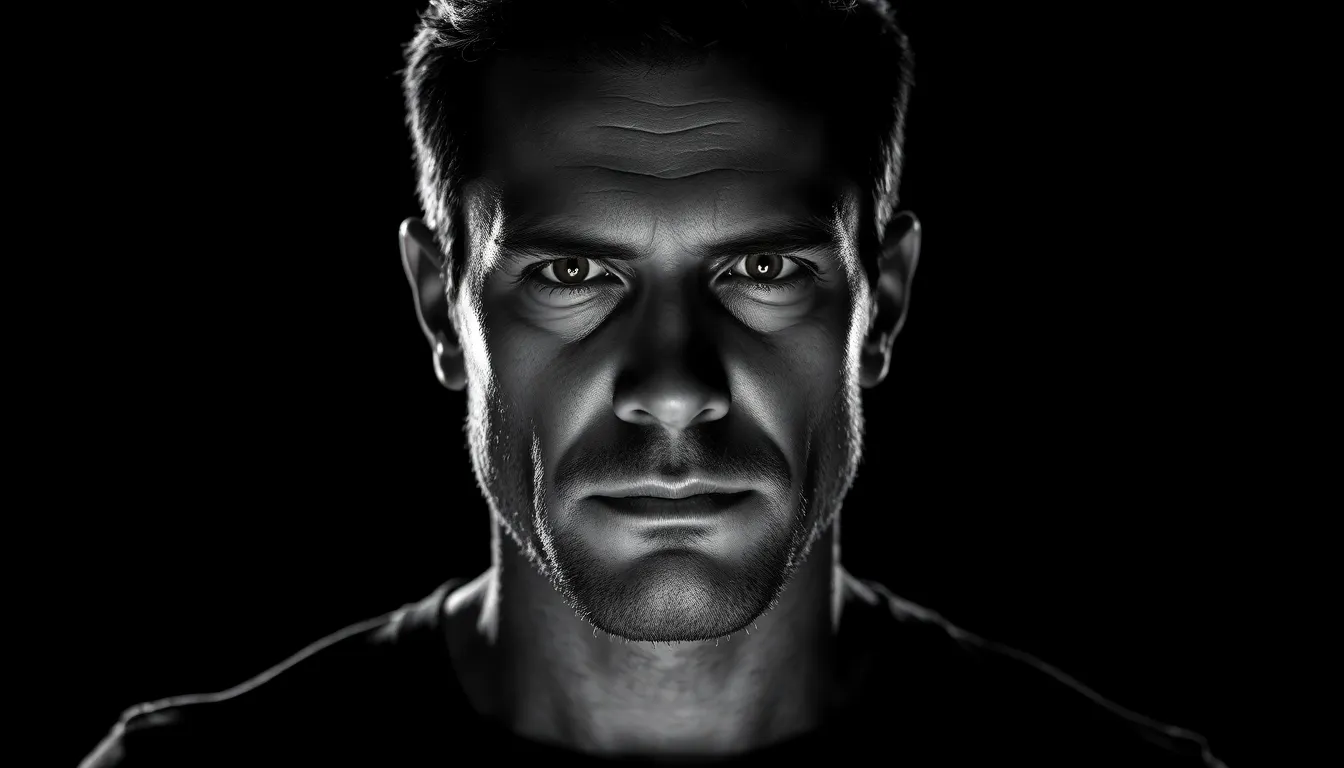
Creating powerful monochrome display pictures requires mastering exact lighting approaches that enhance texture and emotion. We’ll explore three essential dramatic lighting methods that transform ordinary portraits into compelling black and white images.
High Contrast Lighting Methods
High contrast lighting produces sharp distinctions between illuminated areas and deep shadows using a single powerful light source. This technique creates bold, graphic portraits that emphasize facial features, bone structure, and skin texture with remarkable intensity. We recommend positioning one strong light without additional fill lighting to deepen shadows and intensify highlights.
Professional photographers like Lindsay Adler demonstrate how simple one or two strobe setups can produce sophisticated results. The key lies in allowing shadows to fall naturally while ensuring the main light sculpts your subject’s features dramatically. Strong directional lighting creates the textured, masculine aesthetic that makes black and white DPs stand out on social platforms.
Strategic light placement at 45 degrees from your subject generates the most striking contrast ratios. This positioning allows light to carve out facial contours while maintaining enough shadow detail to preserve masculine character. The resulting high contrast imagery conveys confidence and strength through visual boldness.
Side Lighting for Depth
Side lighting positions the light source at an angle to cast pronounced shadows on one side of the face. This technique creates exceptional three dimensional quality by illuminating one half of the face while allowing the other half to fall into shadow. We find this method particularly effective for showcasing strong jawlines and cheekbone definition in men’s portraits.
Texture enhancement becomes dramatically apparent when light rakes across skin at sharp angles. The interplay between light and shadow reveals every detail of facial structure, creating depth that makes flat monochrome images appear sculptural. Side lighting transforms ordinary features into striking visual elements that command attention.
Careful positioning at 60 to 90 degrees from your subject produces the most ever-changing shadow patterns. This angle creates what photographers call “Rembrandt lighting” when executed properly, forming a small triangle of light on the shadowed cheek. The resulting portrait gains immediate visual impact through its bold contrast and dimensional quality.
Backlighting Effects
Backlighting shines light from behind the subject to create rim lighting or halo effects. This technique separates your subject from the background while adding atmospheric drama to black and white portraits. We use backlighting to achieve cinematic separation that makes subjects appear to glow against darker backgrounds.
Strategic reflector placement balances facial shadows when using backlighting as the primary source. Silver reflectors brighten important details like the eyes while maintaining the dramatic rim lighting effect. This combination prevents subjects from becoming complete silhouettes while preserving the striking outline that backlighting provides.
Creative shadow work emerges naturally when combining backlighting with additional light sources. The interplay between rim lighting and carefully controlled fill light creates complex shadow patterns that add narrative depth to portraits. These layered lighting effects produce the sophisticated, professional quality that elevates display pictures beyond simple snapshots.
Casual Black and White DP Concepts for Everyday Appeal
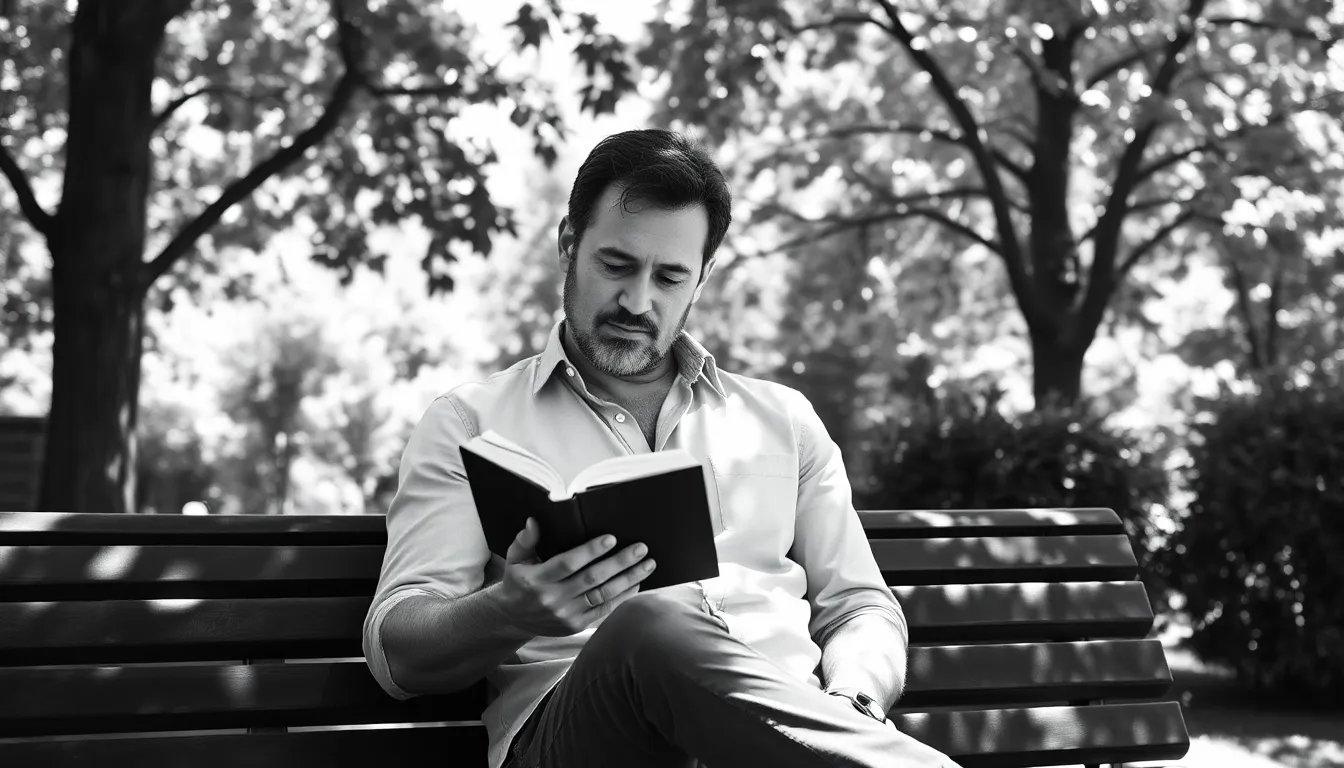
Moving beyond dramatic lighting, we’ll explore approachable monochrome styles that capture authentic moments and natural beauty. These casual concepts work perfectly for men seeking sophisticated yet relaxed display pictures.
Natural Outdoor Settings
Natural Outdoor Settings highlight raw textures and contrasts in daylight photography. We recommend capturing candid moments like walking through a park or sitting on a bench, where natural shadows and light create depth without artificial setup. This style embraces simplicity and authenticity, focusing on genuine expressions rather than forced poses.
Parks, gardens, and tree-lined paths provide excellent backdrops for these casual black and white portraits. Sunlight filtering through leaves creates beautiful patterns that translate beautifully to monochrome photography. The absence of color allows viewers to focus on facial expressions, body language, and the interplay between subject and environment.
Candid Lifestyle Shots
Candid Lifestyle Shots project a timeless and emotive feel by capturing men in everyday situations. We find that photographing natural activities like reading, working, or socializing creates more genuine and impactful display pictures than staged photography.
Reading a book at a coffee shop, typing on a laptop, or captivating in conversation produces authentic moments that resonate with viewers. Black and white processing removes color distractions, accentuating facial expressions, lines, and silhouettes that tell compelling stories. These shots work particularly well because they showcase personality and character through real moments rather than artificial poses.
Urban Street Photography Style
Urban Street Photography Style creates striking display pictures by focusing on men within ever-changing cityscapes. We use the interplay of light, shadow, and architectural lines to frame subjects in compelling ways that capture modern life’s essence.
Alleyways, streets, and urban corners provide dramatic backdrops that enhance the monochrome aesthetic. Architectural elements create natural leading lines and symmetry that draw attention directly to the subject. Shadows and reflections add dramatic effects, while silhouettes or partial profiles evoke mystery and mood.
This approach works exceptionally well because it simplifies complex urban scenes to essential elements of structure and emotion. The monochrome treatment enhances contrasts and textures, creating sophisticated appearances that feel both contemporary and timeless. We recommend using minimalist compositions that focus on texture and contrast rather than busy details that might distract from the subject.
Formal Black and White Display Pictures for Professional Use

Professional black and white display pictures represent the pinnacle of corporate photography, combining timeless elegance with authoritative presence. These monochrome portraits remove color distractions to emphasize facial features, expressions, and texture while conveying the seriousness and professionalism required in business environments.
Corporate Headshot Standards
Composition guidelines focus on head and shoulders framing with centered positioning to create balanced, professional portraits. We recommend maintaining eye level camera angles that establish direct connection with viewers while projecting confidence and approachability.
Expression standards call for neutral to slight smile presentations that convey both seriousness and accessibility. Business professionals should avoid overly casual expressions, instead opting for composed facial expressions that communicate competence and reliability.
Attire requirements emphasize business formal clothing such as well fitted suits, crisp dress shirts, and professional ties. Monochrome photography showcases the texture and structure of formal wear exceptionally well, making high quality business attire essential for impactful portraits.
Background specifications demand plain or softly blurred backgrounds that eliminate distractions and accentuate the subject. Studio settings with controlled lighting ensure clarity and consistency across corporate photography collections.
LinkedIn Ready Portraits
Platform optimization techniques help black and white portraits stand out in LinkedIn feeds and profile searches through their distinctive monochrome appeal. These portraits blend professional seriousness with visual style, creating memorable first impressions for potential business connections.
Consistency benefits emerge from monochrome effects that unify diverse image backgrounds and lighting conditions across different user profiles. We’ve observed that black and white portraits maintain visual coherence regardless of original shooting conditions or equipment variations.
Professional branding advantages include enhanced perception of executive level presence and corporate sophistication. LinkedIn users with monochrome professional portraits often receive higher engagement rates and more connection requests from industry professionals.
Technical specifications for LinkedIn require high resolution images with clear facial details and proper aspect ratios. Portrait orientation works best for profile pictures, while maintaining sufficient resolution ensures clarity across desktop and mobile viewing experiences.
Executive Level Photography
Authority projection becomes enhanced through black and white executive portraits that emphasize leadership qualities and decision making presence. CEOs, managers, and senior leadership roles benefit from monochrome photography’s ability to convey gravitas and executive authority.
Studio requirements include professional lighting setups with key lights, fill lights, and background separation to create polished corporate imagery. Controlled environments ensure consistent quality and eliminate variables that might compromise professional appearance standards.
Confidence communication strategies involve strategic posing, direct eye contact, and composed facial expressions that project leadership capabilities. Executive photographers often employ slight downward camera angles that subtly enhance the subject’s commanding presence.
Corporate compliance standards across industries favor black and white executive portraits for annual reports, website leadership pages, and official company documentation. These formal portraits meet regulatory requirements while maintaining sophisticated visual appeal that reflects organizational professionalism.
Creative Angles and Compositions for Unique Black and White DPs
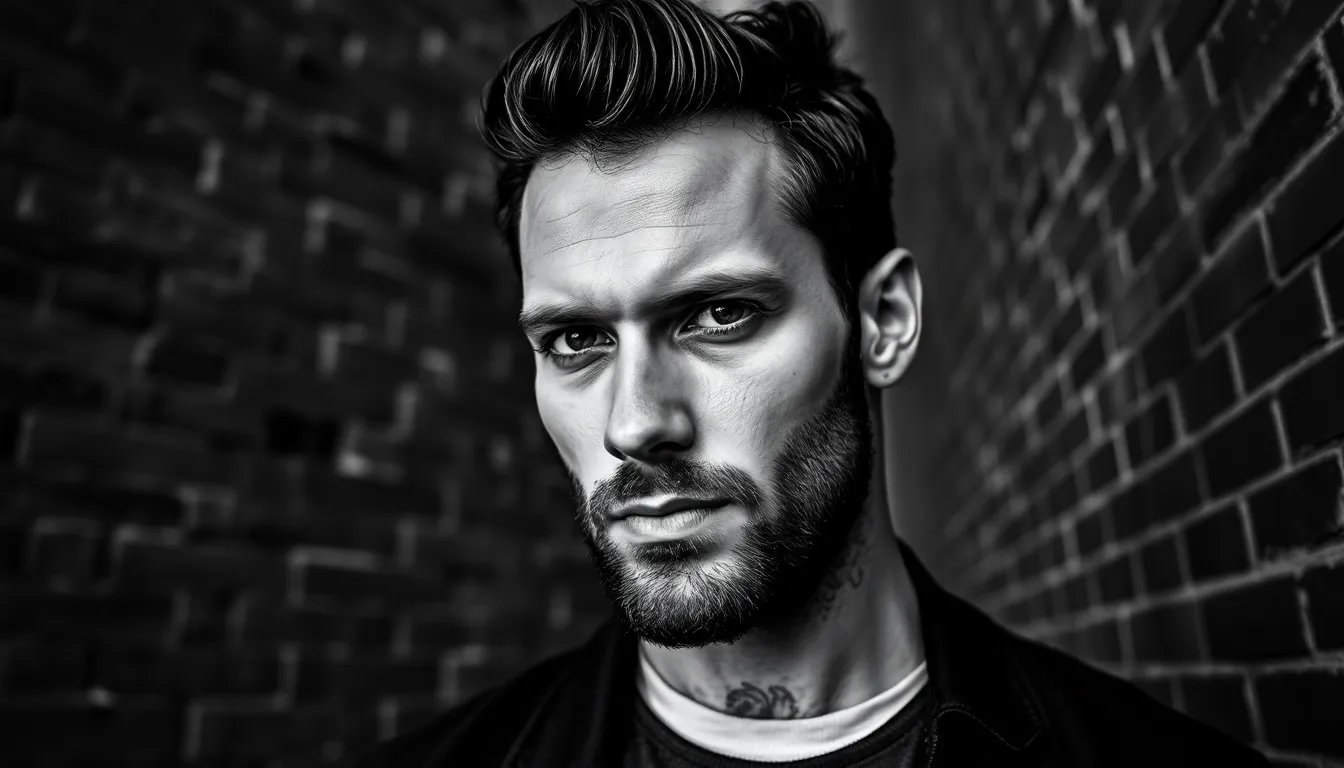
Moving beyond traditional portrait techniques, we’ll explore innovative angles and compositions that transform ordinary monochrome images into compelling visual statements. These creative approaches help you capture distinctive black and white DPs that stand out from conventional profile pictures.
Low Angle Power Shots
Positioning your camera below eye level creates an immediate sense of dominance and strength in male portraiture. This technique elongates the subject’s frame while establishing a heroic presence that commands attention. The low angle naturally emphasizes confidence and authority, making it particularly effective for professional DPs and social media profiles.
Strong directional lighting paired with low angle shots enhances shadows and highlights dramatically. We recommend positioning your light source at a 45 degree angle from below to create depth and dimension in the monochrome image. This combination of angle and lighting produces striking contrasts that add visual power to your display picture.
Shooting from this perspective works exceptionally well for outdoor urban environments. The low angle allows you to incorporate architectural elements like buildings or structures in the background, creating a sense of scale that reinforces the subject’s commanding presence.
Close-Up Detail Focus
Focusing closely on exact facial features intensifies expression and character in black and white portraits. Eyes, beard texture, and skin details become the primary storytelling elements when color is removed from the equation. A wide aperture between f/1.4 to f/2.5 creates sharp focus on these critical details while softly blurring distracting background elements.
Eyes serve as the most crucial element in monochrome portraiture since they convey emotion without color distraction. We emphasize capturing the subject’s gaze with precision, as this becomes the viewer’s primary connection point. Proper focus on the eyes draws attention directly to the most expressive parts of the face.
Detail focused shots work particularly well for professional headshots and LinkedIn profiles. The intimate nature of close up compositions creates personal connection while the black and white treatment adds sophistication and timeless appeal to your display picture.
Environmental Portrait Integration
Including subtle environmental elements in your frame tells a compelling story about the subject without overwhelming the composition. For men’s DPs, incorporating textures like urban walls, natural backdrops, or relevant objects adds meaningful context while maintaining focus on the individual. The key lies in using these elements to support rather than compete with your subject.
Black and white photography enhances environmental integration through shadows and tonal contrasts. We use the interplay between light and shadow to harmoniously blend subject and background, creating depth that guides the viewer’s eye naturally through the composition. This technique transforms simple portraits into narrative driven images.
Urban environments provide particularly rich opportunities for environmental portrait work. Architectural lines, textured surfaces, and interesting light patterns create sophisticated backdrops that complement the subject while adding visual interest to your monochrome display picture.
Essential Editing Tips for Perfect Black and White Men’s DPs
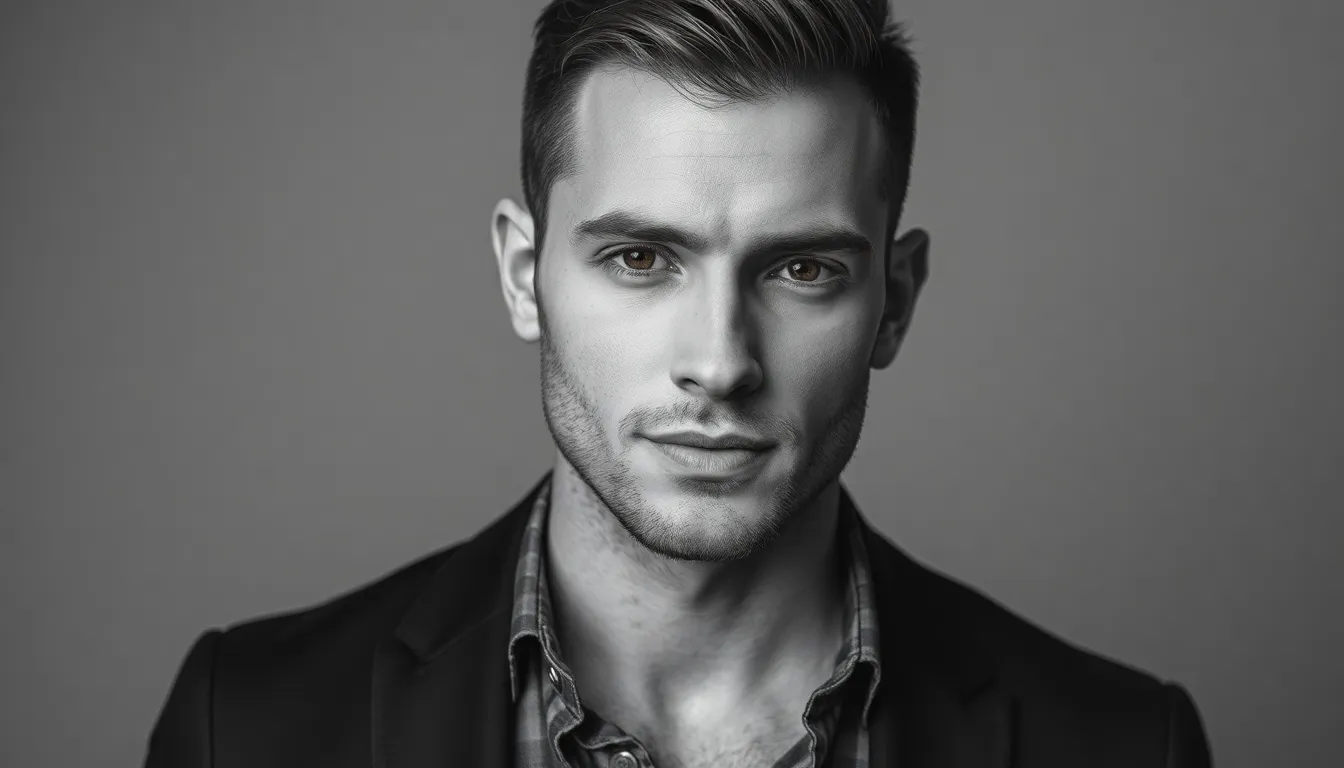
We’ll transform your monochrome portraits from ordinary to extraordinary using professional editing techniques. These three core adjustments will elevate your display picture’s visual impact and professional appeal.
Contrast and Brightness Adjustments
Adjusting contrast becomes crucial for improving the visual impact of your black and white photos. Increasing the whites and blacks intensifies tonal contrast, making images more striking and ever-changing with enhanced depth.
Use software tools like Photoshop’s Black & White adjustment layer, which provides sliders for controlling brightness of exact colors in your original image. Red, yellow, and green sliders allow selective tonal enhancement to exact areas of your portrait.
Apply local adjustments with graduated filters or layer masks to control contrast in different parts of your image. This technique provides depth and dimensionality to facial features while maintaining natural transitions.
View your edits at 100% zoom to ensure accurate brightness and contrast representation throughout the editing process. This prevents over-processing that can diminish image quality.
Grain and Texture Enhancement
Black and white photography emphasizes texture and shapes more than color images ever could. Improving grain adds a classic, artistic feel to your photo while emphasizing skin texture, hair details, and fabric patterns.
Use subtle grain effects to avoid overpowering your image but include enough to add tactile quality to your DP. Most photo editing software offers noise/grain settings or film grain filters for this purpose.
Balance grain intensity with your portrait’s overall aesthetic to maintain professional appearance. Too much grain creates distraction, while too little removes the desired vintage character.
Skin Tone Optimization
Black and white images lack natural color cues, so optimizing skin tone focuses on balancing brightness and contrast. We maintain natural looking skin highlights and shadows without losing facial detail.
Avoid overexposure that washes out skin features or underexposure which obscures important facial details. Proper exposure ensures your features remain clearly defined and recognizable.
Use color sliders in the Black & White adjustment layer to brighten or darken skin regions effectively. Red and yellow sliders typically control skin tone adjustments depending on your original photo’s color composition.
Target exact skin areas using layer masks for precise control over different facial regions. This allows fine tuning of cheekbones, jawlines, and other defining masculine features.
Common Mistakes to Avoid When Creating Black and White DPs
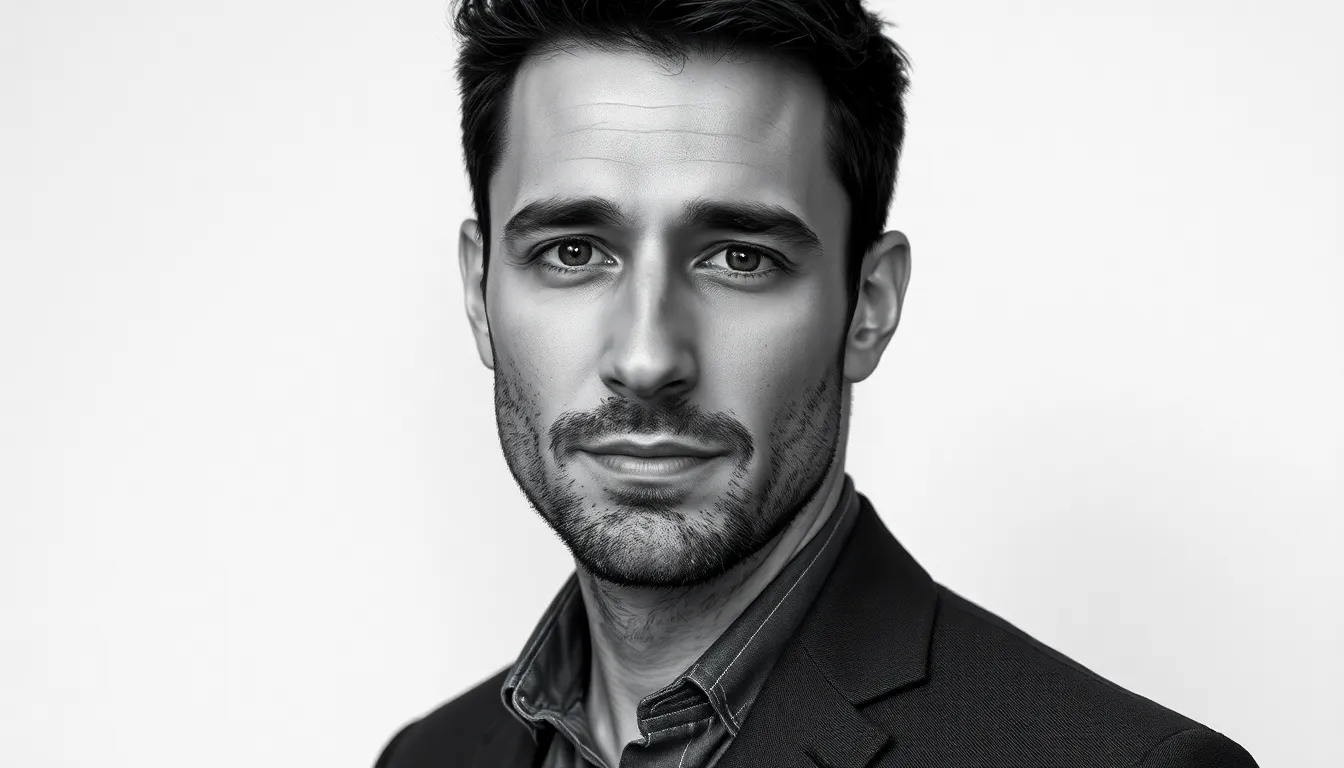
Creating stunning monochrome display pictures requires avoiding several technical and artistic pitfalls that can diminish your image quality. We’ll explore the most critical errors that prevent men from achieving professional looking black and white portraits.
Overexposure and Underexposure Issues
Overexposure washes out essential facial details that make your portrait memorable and impactful. Blown highlights eliminate the subtle tonal variations in skin that create depth and character in monochrome images. We recommend adjusting your white balance and exposure settings in the original color file before converting to black and white to preserve maximum luminance information.
Underexposure creates muddy shadows that lose important facial features and reduce overall contrast. Dark areas become indistinguishable masses rather than defined shadows that add dimension to your portrait. Proper exposure of your original color image ensures you’ll retain shadow detail when converting to monochrome format.
Shooting in RAW format preserves maximum image data for exposure corrections during post processing. RAW files contain significantly more tonal information than JPEG files, allowing you to recover details from both highlights and shadows. This flexibility becomes crucial when fine tuning your black and white conversion for optimal contrast and clarity.
Poor Composition Choices
Lack of clear subject focus weakens the visual impact of your black and white display picture. Monochrome photography depends heavily on contrast, light, and shadow to create compelling images without the benefit of color differentiation. We suggest establishing a strong focal point through strategic positioning and directional lighting.
Distracting elements within the frame compete for viewer attention and reduce the effectiveness of your portrait. Objects, patterns, or textures that don’t contribute to your story should be eliminated or minimized during shooting or editing. Clean compositions with intentional elements create more powerful monochrome images.
Missing tonal range flattens your portrait and reduces visual interest. Effective black and white images contain a full spectrum from true blacks through various grays to pure whites. We recommend composing shots that naturally include this complete tonal range rather than relying solely on post processing adjustments.
Inappropriate Background Selection
Busy backgrounds confuse viewers and detract from your facial features in monochrome portraits. Complex patterns, multiple textures, or competing elements reduce the impact of your black and white conversion by creating visual noise. Simple backgrounds with subtle textures or solid tones enhance subject prominence.
Poor contrast between subject and background makes your portrait appear flat and unprofessional. Light subjects need darker backgrounds while darker subjects benefit from lighter backgrounds to create separation and depth. We suggest testing different background options during shooting to ensure adequate tonal contrast.
Cluttered environments reduce the sophisticated appeal that makes black and white portraits so effective for professional display pictures. Multiple objects, varying textures, or busy architectural elements compete with your facial features for attention. Clean, minimal backgrounds allow your expression and character to dominate the composition.
Best Practices for Sharing Your Black and White DP Across Platforms
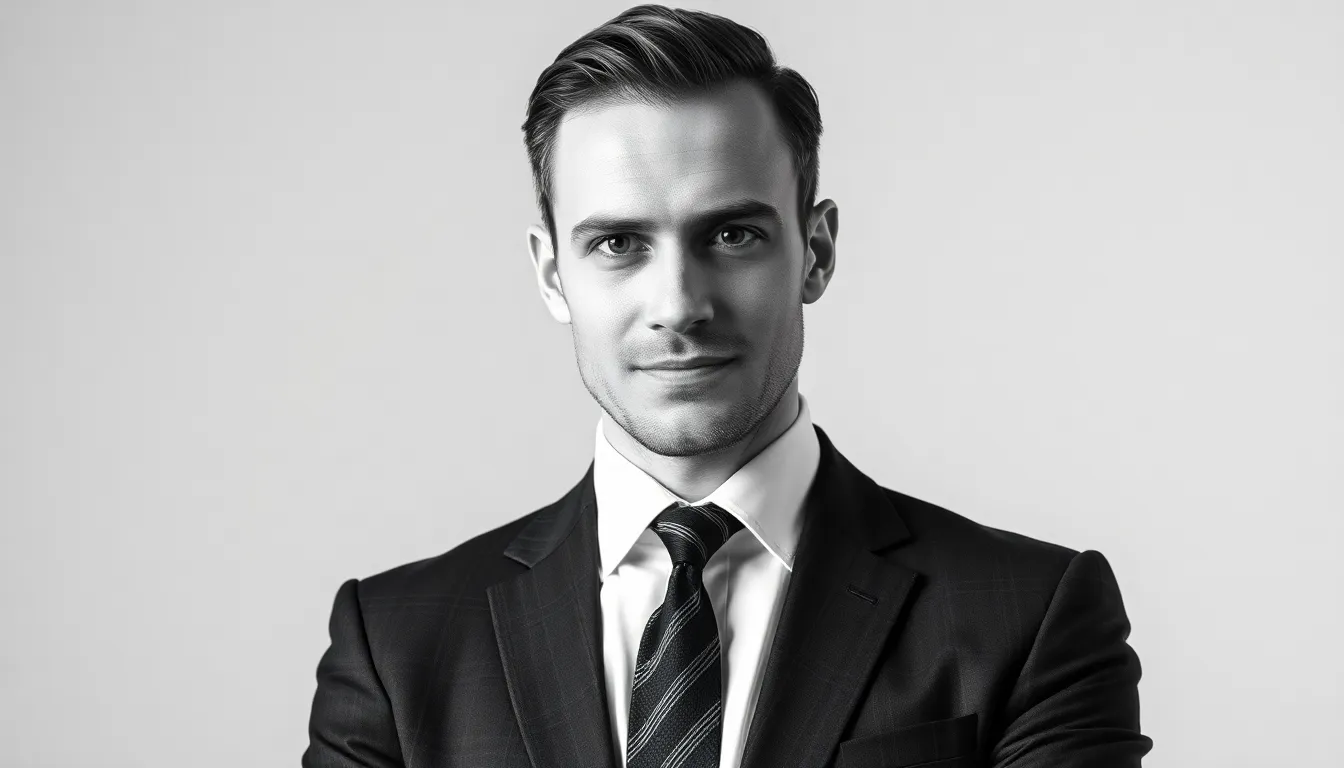
We’ll help you maximize the impact of your monochrome profile picture across different social media platforms. Strategic sharing ensures your black and white DP maintains its professional appeal while meeting each platform’s unique requirements.
Social Media Optimization
Focus on highlighting your face clearly to create immediate visual impact. Your black and white DP should feature sharp focus on the eyes since they engage viewers and create memorable connections with your audience.
Avoid busy backgrounds that distract from your facial features. Clean, uncluttered compositions direct attention to your expression and personality rather than competing visual elements.
Experiment with different contrast and brightness settings suited to your skin tone and hair color for optimal visual impact. These adjustments enhance your natural features while maintaining the sophisticated appeal of monochrome photography.
Test your DP after uploading since some platforms automatically crop or compress images. This verification ensures your carefully crafted black and white portrait appears as intended across all viewing devices.
Profile Picture Sizing Guidelines
Resize your DP to fit each platform’s recommended dimensions to avoid unwanted cropping or distortion. Different social media sites require exact image sizes for optimal display quality.
Choose high resolution images to keep facial details sharp when displayed in various sizes. Quality resolution maintains the professional appearance of your black and white portrait across desktop and mobile viewing.
Prepare multiple versions of your DP sized appropriately for each platform you use. This preparation saves time and ensures consistent visual quality across all your social media presence.
Platform-Exact Considerations
LinkedIn requires 400×400 pixels and benefits from professional black and white portraits with good contrast to stand out in professional feeds. Choose compositions that convey competence and reliability for business networking success.
Facebook displays DPs at 170×170 pixels on desktop, requiring simple backgrounds and centered face positioning for maximum clarity. Focus on expressions that reflect your personality while maintaining approachability.
Instagram uses 320×320 pixels with square cropping that emphasizes facial features effectively. Artistic black and white compositions perform well on this visually driven platform.
Twitter displays at 400×400 pixels, demanding high contrast and clarity to remain noticeable in the platform’s fast moving timeline. Bold monochrome treatments help your profile stand out among colorful content.
| Platform | Recommended Size | Key Optimization Tips |
|---|---|---|
| 400×400 pixels | Professional contrast, business appropriate expressions | |
| 170×170 pixels | Simple backgrounds, centered positioning | |
| 320×320 pixels | Square composition, artistic emphasis on features | |
| 400×400 pixels | High contrast, timeline visibility focus |
Conclusion
We’ve covered everything you need to create stunning black and white display pictures that make a lasting impression. From classic portrait styles to dramatic lighting techniques and professional editing tips these strategies will help you create monochrome images that stand out across all social media platforms.
Remember that the best black and white DPs combine technical excellence with authentic expression. Whether you’re going for a minimalist approach or vintage-inspired aesthetics the key lies in understanding your lighting mastering composition and avoiding common pitfalls that can diminish your image’s impact.
Your monochrome display picture is more than just a profile photo—it’s a powerful tool for personal branding that communicates confidence sophistication and professionalism. Take these techniques and start experimenting to discover which black and white style best represents your unique personality and goals.
Frequently Asked Questions
Why are black and white display pictures becoming popular on social media?
Black and white DPs convey timeless elegance, sophistication, and confidence. They create strong visual impact on platforms like LinkedIn and Instagram, helping users stand out while maintaining a professional appearance. Monochrome photography eliminates color distractions, focusing attention on facial features and expressions, making them ideal for personal branding.
Do I need professional photography skills to create stunning black and white DPs?
No, you don’t need professional skills to create impressive black and white display pictures. With basic understanding of composition, lighting techniques, and simple editing adjustments like contrast and brightness, anyone can transform ordinary photos into striking monochrome images that reflect personal style and enhance online presence.
What are the key elements of a classic black and white portrait for men?
Classic black and white portraits focus on clean composition, proper lighting, and strong facial features. Traditional headshots emphasize clear portraits with minimal distractions, while professional business portraits require well-fitted attire and confident posture. Proper camera settings and composition techniques are essential for creating memorable display pictures.
How can I create dramatic lighting effects in black and white portraits?
Use high contrast lighting positioned at 45 degrees for maximum facial impact. Side lighting enhances depth by casting pronounced shadows, while backlighting creates rim lighting effects that separate subjects from backgrounds. These techniques add narrative depth and professional quality to monochrome portraits.
What makes a good minimalist black and white DP?
Minimalist black and white DPs require clean backgrounds with solid colors or subtle gradients, simple lighting setups with soft transitions, and geometric framing techniques. Focus on eliminating distractions while using architectural elements and strategic positioning to draw attention to facial features without cluttering the aesthetic.
How do I optimize black and white DPs for different social media platforms?
Each platform has specific requirements: LinkedIn (400x400px), Instagram (320x320px), Facebook (170x170px), and Twitter (400x400px). Use high-resolution images, ensure clear facial visibility, avoid busy backgrounds, and prepare multiple versions. Adjust contrast and brightness settings based on platform-specific display characteristics.
What are common mistakes to avoid when creating black and white DPs?
Avoid overexposure that washes out details and underexposure that creates muddy shadows. Don’t use poor composition choices, inappropriate backgrounds, or unclear subject focus. Always shoot in RAW format to preserve tonal information, maintain full tonal range, and eliminate distracting elements for maximum visual impact.
Can casual black and white DPs work for professional settings?
Yes, casual black and white DPs can work professionally when done correctly. Natural outdoor settings with good lighting, candid lifestyle shots showing authentic activities, and urban street photography styles can create sophisticated monochrome images that maintain professionalism while appearing more approachable and authentic.
What editing adjustments are essential for black and white DPs?
Focus on three core adjustments: contrast and brightness for visual impact, grain and texture enhancement for classic appeal, and skin tone optimization for defined facial features. Use selective tonal enhancement, local adjustments for depth, and careful balance to ensure faces remain recognizable in monochrome.
How do vintage-inspired black and white DPs differ from modern styles?
Vintage-inspired DPs use film noir aesthetics with dramatic shadows, retro Hollywood glamour with formal attire, and classic gentleman styling with timeless accessories. They emphasize high contrast editing, chiaroscuro lighting techniques, and sophisticated grooming details that capture early to mid-20th century photography elegance.
